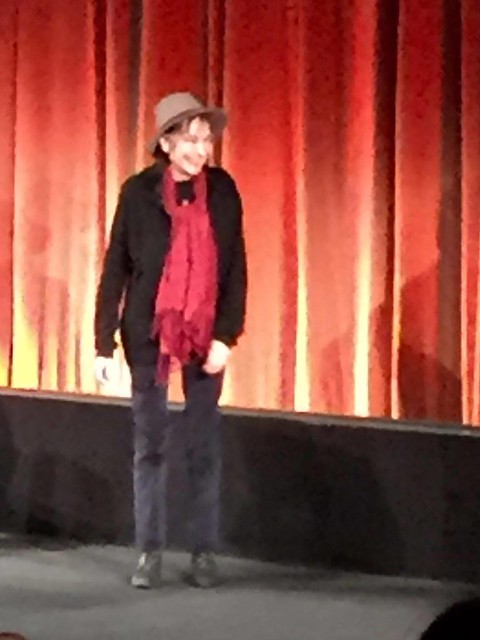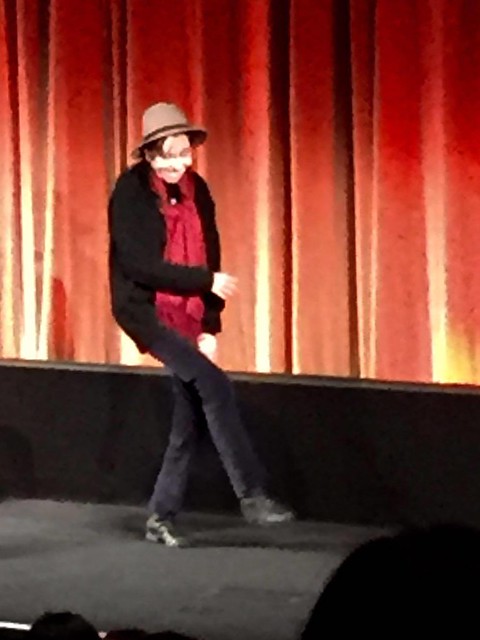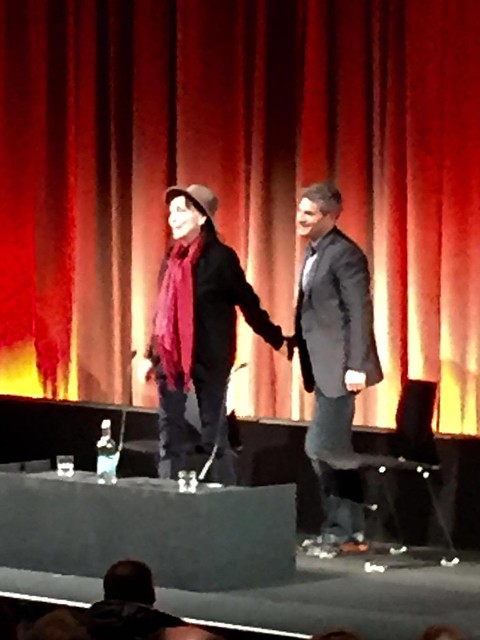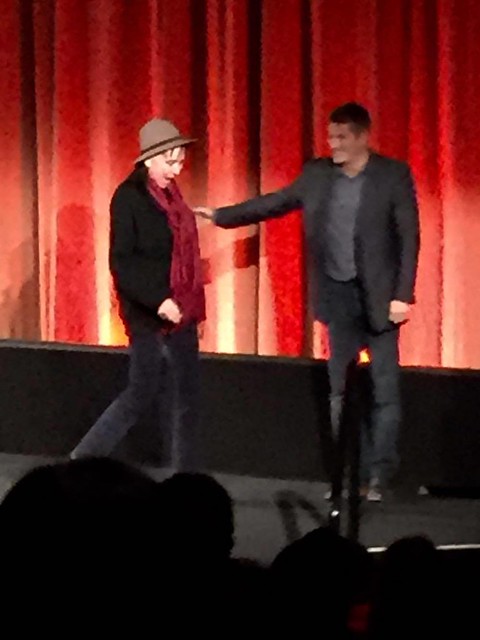/ The glorious Anita Ekberg (1931 - 2015) as Sylvia in La Dolce Vita (1960) /
From the Facebook events page for the Lobotomy Room Goes to the Movies film club on 28 August 2016 at Fontaine's:
Attention, jaded Continental sophisticates! Embrace the
spirit of Eurotrash hedonism (and pretend we’re still in the EU) when Lobotomy
Room presents a FREE special decadent Bank Holiday Sunday [28 August] screening
of Federico Fellini’s carnival-esque and hallucinatory epic masterpiece La
Dolce Vita (1960)! You know that iconic image of voluptuous Swedish sex
bomb Anita Ekberg frolicking in Rome’s Trevi Fountain? That’s from La Dolce
Vita – one of the most stylish movies ever made! It captures the acme of
Italian glamour: the cars, the clothes, the nightlife (no one films debauched nightclub,
party and orgy scenes like Fellini in his 1960s pomp) and most of all – the
sunglasses! While you watch the film, take the edge off your hangover with
negronis or glasses of Prosecco! Needless to say it’s illegal to smoke in the
Bamboo Lounge, but feel free to keep your shades on!

Because of the film’s running time (three hours!), the film
starts earlier than usual at 6 pm. Arrive circa 5:30 to order your drinks and
grab the best seats downstairs in the Bamboo Lounge. (I’ll be down there
playing music and screening vintage “nudie cutie” blue movies before the main feature).
The film is FREE and seating is limited. If you’re feeling proactive, contact
Fontaine’s to reserve a seat in advance: email ruby@fontaines.bar or call 07718
000546.

/ The love-hungry, pleasure-chasing international sin set is coming – to Lobotomy Room’s FREE screening of Federico Fellini’s La Dolce Vita THIS Sunday! In the basement Bamboo Lounge of Fontaine’s! It promises to be an orgiastic Bacchanal! See the film condemned by the Catholic Church as blasphemous and banned in Spain until 1975! (By the way: in 2016 Photobucket.com keeps deleting this photo saying it violates their standards! La Dolce Vita is still freaking out the squares all these decades later!) /
This represented the first time Lobotomy Room ever presented
a serious art film with subtitles! In fact, I warned the attendees: "Do you
realise you’ve signed-up for a three-hour black-and-white foreign-language film
with subtitles? The doors are now locked – you aren’t going anywhere!" When I first
proposed La Dolce Vita to Ruby (Fontaine’s glamorous boss lady), she expressed
doubts whether anyone would actually want to sit through it. In fact we
pulled-in a more than decent house and everyone sat rapt and intoxicated by Fellini’s
vision. His filmmaking is so fluid, swirling and seductive, the three hours flew by.
As usual, before the film I stood up and blurted-out a
garbled, half-assed introduction. (My public speaking style can definitely best
be described as “blurted”). I definitely mentioned that in the spirit of La
Dolce Vita, I had a thunderous hangover that Sunday. Anyway, here is a summary of the points and fun facts I
spewed (obviously I've expanded considerably here):
/ See the world's most handsome man (Marcello Mastroianni in La Dolce Vita) suffer a profound existential crisis! /
Federico Fellini (1920 – 1993) had already made a few great
films by this point (I particularly love 1957’s Nights of Cabiria), but the international
success of La Dolce Vita really catapulted him to worldwide fame.
The film was sizzling and scandalous for its time. Perhaps inevitably
the Catholic Church hated La Dolce Vita, considering it blasphemous (it was
banned in Franco's Spain until 1975!). The film lets Fellini have his cake and eat it
too: it’s a critique or exposé of the moral
bankruptcy and hollowness of “the sweet life” (fame, wealth, celebrity and
hedonism) – but we still get to enjoy watching the lengthy lurid scenes of orgies,
nightlife and the beautiful people cavorting at length. (Dolce Vita is an “art
film” but that’s the template for pretty much all “cautionary” sexploitation
films since too!).
La Dolce Vita takes a state-of-the nation overview of
Rome’s post-war upheaval. The themes of alienation and the collapse of
conventional morality are personified by the existential angst of its anti-hero Marcello (played by Marcello Mastroianni), torn between art (writing the Great Novel; the world
of poetry, philosophy and spirituality espoused by his intellectual friends)
and commerce (his job as a sensational tabloid journalist writing about the superficial
realms of cafe society and show business).
To contrast against the tawdry Roman nightlife centred around Via Veneto, mid-way through the film we see Marcello and his fiancée Emma attend
his friend Steiner’s intellectual high-toned salon full of poets, artists and the
literary set (complete with a sari-clad Asian woman seated on the floor
strumming the guitar and singing folk songs and guests reciting poetry aloud). No doubt I’m missing the point entirely, but
the final climactic orgiastic party (where the divorcee does a striptease
writhing on the floor) looks far more fun! (Bear in mind this film was made in
1959, so these are orgy scenes where everyone remains fully clothed! See also: Michelangelo
Antonioni’s The Red Desert).

/ One of my favourite party scenes in La Dolce Vita, set in the crumbling ruins of a castle (the gorgeous blonde in the centre of the dissolute aristocrats is Nico!) /
An interesting side note is the presence of clearly-identified
gay and cross-dressing characters in several of these nightclub and party scenes.
Fascinating as it is to see frank and overt LGBT
representation in a film made in 1959, what’s problematic today is that Fellini
seemingly employs them to depict how low Marcello has sunk! (If you’re at a
party surrounded by pretty chorus boys frolicking in drag, you’ve basically reached Dante's inner
circle of hell).
Seen today, La Dolce Vita is incredibly prescient in its anticipation of
the relentless celebrity and gossip culture we are now saturated in and - for better or for worse - take
for granted as a constant backdrop to our daily lives. (This is, famously, the film where the
expression “paparazzi” for celebrity photographers came from: Marcello’s sidekick
and photographer friend is called Paparazzo).
The film also works as a time capsule of the late fifties period
when international film productions started flooding Rome's Cinecittà Studios (leading to it being nicknamed "Hollywood on the Tiber"). A lot
of terrible gladiator, sword-and-sandal and Biblical epics were made at Cinecittà during these years,
but so too were parts of the mega-budget 1962 Liz Taylor version of Cleopatra. Weirdly, almost all of La
Dolce Vita itself was shot within the confines of Cinecittà as opposed to “on location.” (For
example, Fellini painstakingly recreated Via Veneto in the studio). Sadly, the particular studio of Cinecittà where most of La Dolce Vita was made was destroyed in a fire in 2012

La Dolce Vita is loosely structured around Marcello’s fleeting
encounters with a series of beautiful women. The most fondly-remembered and
iconic of these is probably the truly statuesque Anita Ekberg as visiting
Hollywood starlet Sylvia, in town to make a film at Cinecittà. (I love it
when - during Sylvia’s sensational publicity stunt arrival at the airport - one
of the reporters turns to Marcello and admiringly declares her a “magnificent
chunk of woman!”). Ekberg is probably essentially playing a cartoonish version
of herself, but it’s nice to think Sylvia’s characterisation (especially the
campy, cooing little girl delivery) is a bit influenced by Jayne Mansfield. Like Sylvia and her insecure boozy actor
husband (played by Lex Barker), certainly sex kitten-gone-berserk Mansfield and
her muscle-bound former Mr Universe husband Mickey Hargitay spent a lot of time
stirring up trouble and making terrible movies in Rome in the early sixties. One bit does feel like an explicit tribute to Mansfield: the
party scene where Frankie (one of the visiting Hollywood actors working in Rome)
hoists Ekberg over his head and twirls her around – that was one of
Mansfield and Hargitay’s favourite attention-seeking party tricks.

/ Mickey and Jayne in action /
(By the way: the famous Trevi fountain scene was shot in the
middle of winter. Mastroianni wore a
wet-suit under his clothes and slugged vodka to keep warm. Fellini recalled that Ekberg
didn’t complain about the cold at all).
/ Who’s that girl? The mystery blonde with Marcello Mastroianni is – Nico! Yes, that Nico – long before the eternally enigmatic singer was discovered by Andy Warhol and joined the Velvet Underground as husky-voiced chanteuse, German fashion model Nico memorably appeared in La Dolce Vita as one of the series of beautiful women Marcello encounters on his nocturnal jaunts through Roman nightlife. And the role was a real stretch for her – she’s playing a fashion model called Nico!/
/ Fellini and Nico during the filming of
La Dolce Vita /
Still in her early twenties, Nico was then what we now would call an in-demand, international “supermodel." I’m probably not very objective (the gloomy German diva is my
all-time favourite singer), but I think her performance in
La Dolce Vita is adorable, natural and –
perhaps surprisingly considering Nico’s later icily-serious, gravely-composed, heroin-ravaged
tortured artist image – very funny. If
you’ve read Richard Witt’s 1993 biography
Nico: The Life and Lies of an Icon or
seen the 1996 documentary
Nico: Icon, you’ll know
La Dolce Vita really captures
what Nico was like at that period in her life: still un-corrupted, insouciant and childlike, jet-setting around the world on modelling assignments.
/ See Anouk Aimee as the most elegant wealthy nymphomaniac in film history! /
/ The fabulous Anouk Aimee in La Dolce Vita /
The most complex and inscrutable of Marcello’s women is
Anouk Aimee as the bored, haughty heiress Maddalena.
I’ve already written at length about Modigliani-faced French actress Anouk Aimee’s performance as
Maddalena, but seeing
La Dolce Vita again I was struck by two things: 1) her voice is dubbed throughout by an
Italian actress (having another actor dub someone’s voice was routine in
Italian cinema at the time but feels weird today. Aimee’s own distinctive whisper-soft
voice is notably different), for most of her screen-time she keeps black
sunglasses clamped-on and I suspect the bouffant hairstyle she sports is a wig.
So Anouk Aimee is essentially in disguise! But Maddalena’s alluring sense of remote,
Garbo-like inscrutability and melancholy is entirely Aimee’s own. 2) Aimee is so thin in
La Dolce Vita, she’s
almost wraith-like (her waist is worthy of comparison to Vampira’s). Also:
virtually all of
La Dolce Vita’s main players are dead now. Aimee is still alive (she’s a very stylish
84-year old). So is Yvonne Furneaux (now
88), the French actress who plays Marcello’s neurotic and suicidal
fiancée Emma.
Furneaux appeared in some pretty
distinguished European art films in addition to
La Dolce Vita, like the early
Antonioni film
Le Amiche (1955) and as Catherine Deneuve’s sister in
Repulsion
(1965). Furneaux really excelled at playing mentally unstable women!

If you’ve never watched
La Dolce Vita before, anticipate
being taken aback by just how troubling the film is. (Afterwards I spoke to one
of the attendees who’d never seen the film before. She was surprised by how
dark
La Dolce Vita was: she was expecting something sweeter and more Audrey
Hepburn-esque. ) The film is fondly-remembered as a sentimental classic of
mid-century European cinema, but Fellini’s vision is deeply un-consoling,
unexpectedly incorporating suicide and infanticide. (Even religion is
depicted as just another cynical form of show business. No wonder the Catholic
Church hated it!).
La Dolce Vita begins as Marcello’s existential crisis and concludes
with his permanent journey into darkness. Bravely, Fellini makes Marcello
become progressively more unsympathetic and misogynistic as the film proceeds.
(Women get casually slapped around and roughed-up a lot in
La Dolce Vita). An
enduring masterpiece of style and substance,
La Dolce Vita deserves its status
as one of the most chic films ever made (the nightclub scenes! The cha cha
music!), but it’s the uncompromisingly bleak ending that lingers in your
memory.

/ I love this candid shot. Lunch break on the set of La Dolce
Vita! The people assembled here are like European art cinema royalty of the fifties
and sixties: Marcello Mastroianni, Anouk Aimee, Federico Fellini and Pier Paolo
Pasolini (the controversial queer filmmaker and poet collaborated on La Dolce
Vita’s script). Note that they are being serenaded by an accordion player while
they dine – the sweet life indeed! /













































































